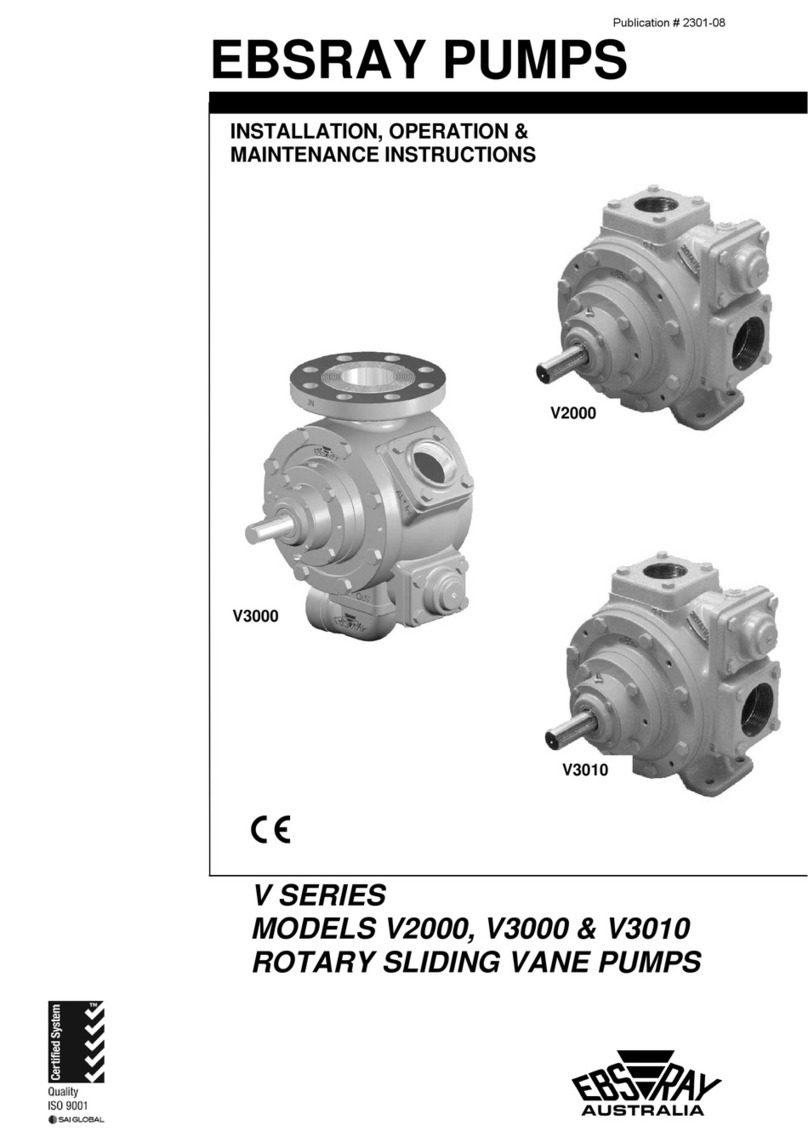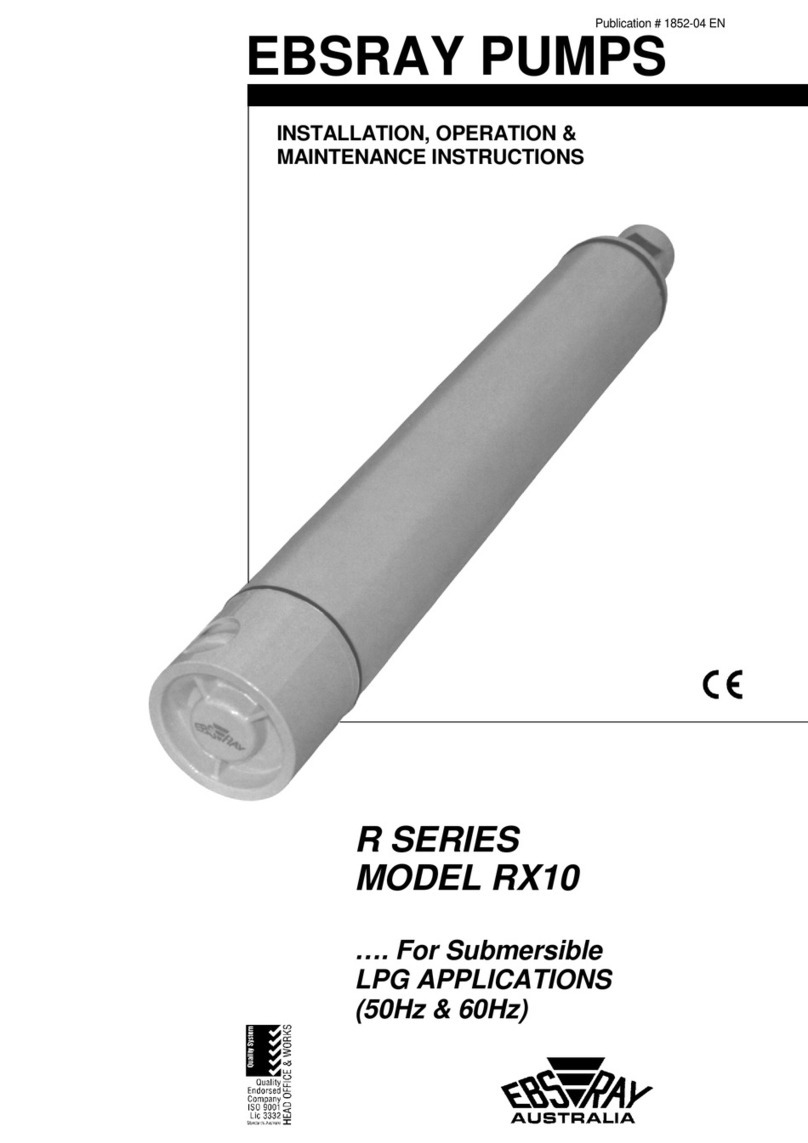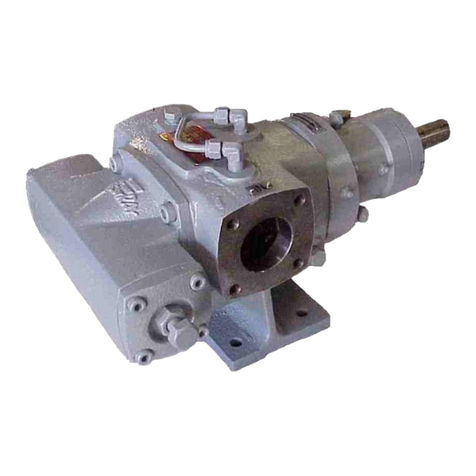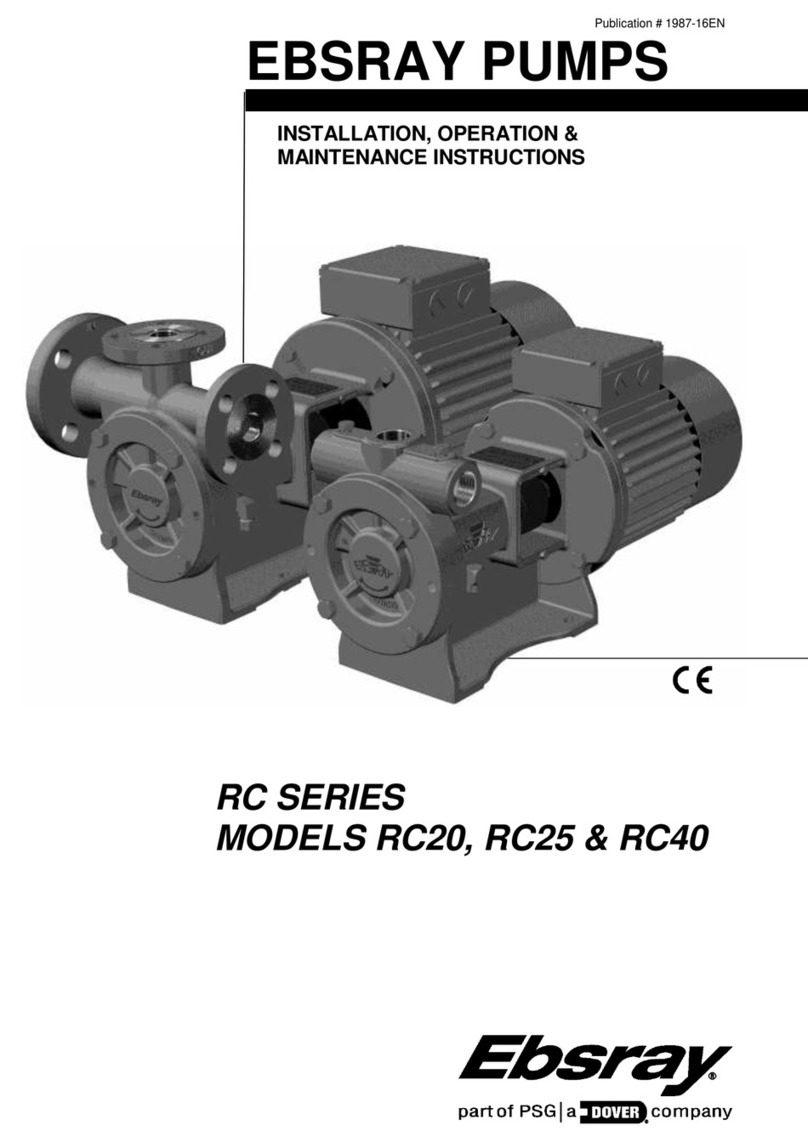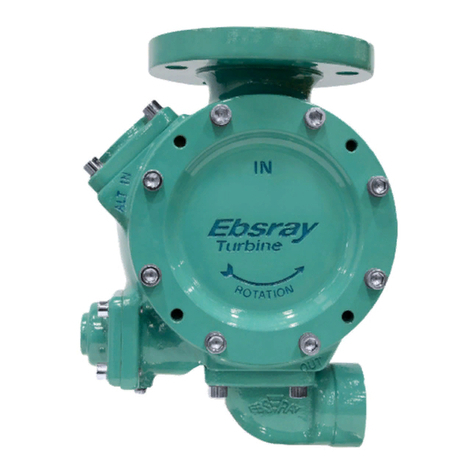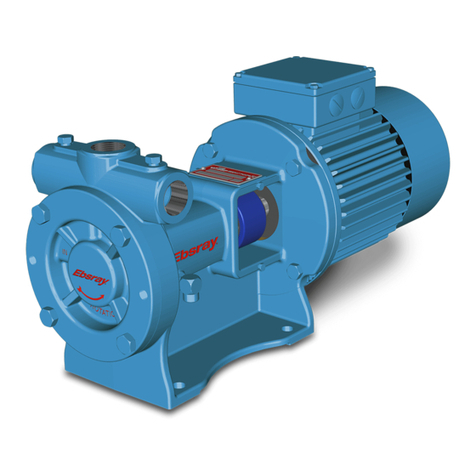
6
4.3 DISASSEMBLY
CAUTION: Take care not to damage components by
prising or levering in order to release fits.
1. If fitted, remove Bypass Valve Adjusting Screw Cap,
Gaskets, Locknut, Adjusting Screw, Spring and Bypass
Valve.
2. Remove Gland Nut.
3. If fitted with packed gland, remove Gland. If fitted with
mechanical seal, carefully remove Gland complete with
Locating Pin, O-Ring and Seal Seat. Take care to
avoid damage to the Seal Seat.
4. Remove Cover and Cover Gasket.
5. Push Rotor on Shaft assembly through body.
6. a. If fitted with packed gland – remove packing.
b. If fitted with mechanical seal – remove
remaining mechanical seal components from
Body.
4.4 INSPECTION
Inspect components for damage or excessive wear. Note
that the typical wear pattern of components in EBSRAY’s
Rotary Internal Gear pumps tends to compensate each
other and working clearances are to some extent
maintained by this compensation. If pump performance has
been satisfactory, existing components, although worn may
still have adequate life and could be used provided any
burrs or sharp edges are removed prior to reassembly.
Major refurbishing of the pump should be done in line with
reconditioning to an ‘as new’ status as replacing or
repairing one component will have an effect on other
components and the working clearances of the pump.
Table of Standard ‘A’ Clearances (mm)
Std Running Clearances ZB120 Z580
Diametral – Outer Rotor to Body 0.013-0.038 0.069-0.101
Axial – Rotors to Cover 0.026-0.050 0.026-0.076
Diametral – Shaft to Bearing 0.008-0.025 0.008-0.030
Diametral – Rotor Pin to Bearing 0.013-0.033 0.013-0.035
Carbon Bearing Clearances when fitted
Diametral – Shaft to Carbon Bearing 0.008-0.025 0.008-0.025
Diametral – Rotor Pin to Carbon Bearing 0.010-0.020 0.026-0.050
Notes:
1. Dimensions stated are design parameters.
2. Efficient suction and discharge performance are achieved
when the pump is maintained within these dimensions,
however adequate performance may still be achieved with the
clearances and dimensions outside those stated if application
parameters allow.
4.5 REASSEMBLY – PRELIMINARY
1. Ensure all parts are clean and free from burrs, etc. Do
not round off sharp edges of rotors as this may affect
performance.
2. Lightly smear all O-Rings and lapped faces of
mechanical seals with a compatible, good quality
lubricant before assembling.
3. Ensure correct orientation of components.
4.6 REASSEMBLY
Note: Factory fitted carbon bearings (when used) are a
press fit – post machined to ensure concentricity and
correct sizing to achieve correct running clearances. If
replacing carbon bearings ensure proper fitting techniques
are employed.
1. Position Rotor on Shaft assembly in Body
2. Measure depth from Body face to Rotor tooth.
3. Measure the depth of Cover step.
4. Determine the gasket thickness required to obtain the
correct running clearance.
5. Fit Inner Rotor over Inner Rotor Pin in Cover and with
the required Gaskets, fit Cover assembly to Body.
6. If fitting Packed Gland:
Fit required packing ensuring that gaps in each ring are
staggered. Fit Gland and Gland Nut.
Note: Do not overtighten Gland. Gland should be
adjusted on commissioning to allow a small amount of
seepage.
5. If fitting Mechanical Seal:
a. Slide Circlip onto Shaft, slide Circlip Retainer along
shaft and push on until the Circlip locates in the
circlip groove.
b. Slide the remaining seal components along the
shaft in the following order: Spring, Drive Washer,
O-Ring and Seal Face.
c. Fit the O-Ring to the Seal Seat then fit the Gland to
the Seal Seat ensuring it seats correctly over the O-
Ring and that the Locating Pin is correctly engaged.
d. Fit the gasket to the Gland then slide the Seal
Seat/Gland assembly along the Shaft and lock into
position with the Gland Nut.
6. Ensure freedom of rotation of shaft.
7. If fitted with Bypass Valve
a. Insert Bypass Valve into housing in Cover.
b. Insert Spring into housing
c. Screw Bypass Valve Adjusting Screw into housing
d. After adjusting Bypass Valve pressure setting, lock
and seal Adjusting Screw by fitting, in the following
order, Gasket, Locknut, Gasket and Adjusting
Screw Cap.
Note:
To increase bypass pressure screw Bypass Valve
Adjusting Screw IN
To decrease bypass pressure screw Bypass Valve
Adjusting Screw OUT
CAUTION: Do not exceed specified pump/system design
pressures.



















